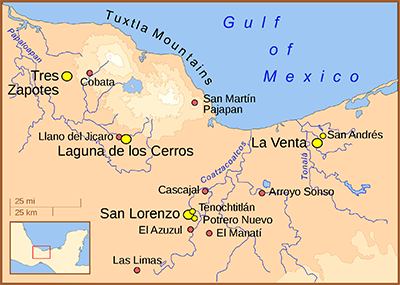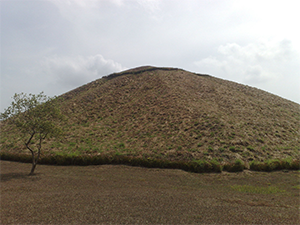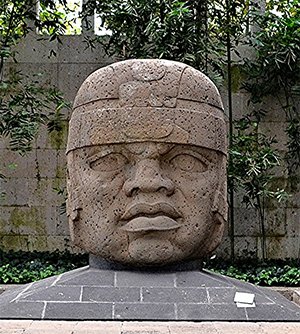The Ancient Olmecs
The Olmecs were one of the first advanced civilizations in Mesoamerica and, as such, influenced later, more well-known civilizations in that area. Historians call the people of this civilizations Olmecs, but that is an Aztec name, meaning "rubber people." Some current research suggests that the Olmecs may well have come from West Africa and have called themselves the Xi People (pronounced "She"). 
Historians estimate that the Olmec civilization arose somewhere between 1400 and 1200 B.C. (although some estimates push this back to 1600 B.C.). The people found very helpful the land and waters of the Coatzacoalcos river basin, with the Gulf of Mexico to the north. They began eating fish and game, which they hunted; later, they grew beans, maize, squash, sweet potatoes, and other crops to supplement that diet. As the civilization grew, it spread out, to what is now southern and western Mexico and Guatemala. Perhaps the most well-known Olmec site was San Lorenzo, in what is now the Mexican state of Veracruz. Archaeologists have found evidence there of mound structures and a drainage system. One intriguing find has been what many believe to be a ball court. The Maya were the most famous players of a game that required participants to guide a rubber ball through a high stone hoop without using their hands, but many historians think that the Olmecs played an early version of this game; prime evidence of this is the discovery of rubber balls dating to early Olmec times in an area not far from San Lorenzo. 
Another prominent Olmec site was La Vanta, in what is now Tabasco. This site rose to prominence about the time that San Lorenzo declined, about 900 B.C. At La Venta have been found the remains of what was once a very large step pyramid. Other known Olmec settlements included Cacahuaqui, Juxtlahuaca, Laguna de los Cerros, Oxtotitlan, Teopantecuanitlan, and Tres Zapotes. 
Prime among the remnants of the Olmec civilization are the colossal stone heads, some of which still adorn wings of modern museums. The heads weigh several tons and are, in some cases, more than 10 feet in height. Moreover, archaeologists have discovered that the stone heads rested, in some cases, dozens of miles from where the stone was quarried. Because the heads are so large and are the most prominent surviving evidence of the Olmec civilization, historians have generally assumed that the heads depicted rulers or authority figures of some sort and that other stone and ceramic figures did the same. However, the numerous digs in lands lived in by Olmecs have produced no substantial evidence to describe the political organization of the civilization in any kind of detail. The Olmecs also used stone to carve stele, in many cases to represent historical events. 
Olmec artists crafted other, much smaller pieces, many of them jade. Archaeologists have found several well preserved jade face masks. Also famous are the various Kunz axes, made of jade, found at several Olmec sites; these are shaped like the head of an axe but, historians think, were used more as ceremonial pieces than as tools or weapons. Several museums around the world also feature Olmec-made bottles and other vessels and ceramic figurines. The Olmecs had a systemized belief system, led by a priest equivalent, and they performed regular rituals, including occasional sacrifices of both animals and humans. Historians do not know what names the Olmecs gave to their gods. Records do indicate that these people did identify natural phenomena such as weather with certain gods. Also revered were animals, particularly caimans, eagles, and jaguars. Olmec traders found willing recipients in other civliizations for jade, mica, obsidian, and rubber. Others also prized Olmec pottery. The Olmecs abandoned nearly of these settlements by 350 B.C. Their successors in the area, namely the Aztecs and the Maya, adopted many Olmec traditions, including the drinking of chocolate and the use of a Long Count calendar.
|
|
Social Studies for Kids
copyright 2002–2026
David White




